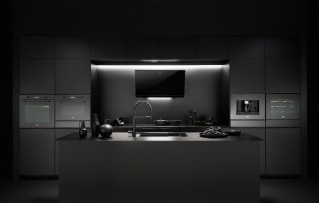A renowned personality that goes well beyond the confines of the gourmand cuisine, Davide Oldani is considered to be the inventor of what he named as "Pop Kitchen", a high-quality catering service, attentive to the balance of contrasts, but able to impose himself for experimentation and visual research. Struggling with the reopening of his D'O restaurant in Cornaredo, the Milanese chef is testing a new solution to reconcile the increased need for hygiene with the desire to find his guests again after the long months of lockdown.

Contributing to this new attempt at mediation there is a component as invisible as effective: a paint, Healthy.Wood, launched by the Italian company Milesi in a wide range of finishes as an additional ally to the needs of sanitation of public and domestic spaces. The heart of the ground-breaking leap of the product is a chemical element whose antiseptic properties have been known since ancient times: silver. Its sanitizing particles are directly integrated in the formulation of Healthy.Wood paints, guaranteeing an even distribution over the entire surface, which is thus perfectly resistant to bacteria in all its parts, making the use of disinfectants superfluous. Since it doesn't evaporate, the sanitizing action lasts forever, even on surfaces which are frequently cleaned with particularly aggressive detergents, and does not alter the aesthetic characteristics of the finish.
Milesi is currently involved in the "Scuola Carugo" project, supporting the sanitation and upgrading of the homonymous school complex in the province of Como. Here, desks, chairs and canteen tables will be painted with Healthy.Wood sanitizing finishes, so as to ensure the reopening of the new school year in total safety. We asked Davide Oldani, who has entirely designed the furniture of his restaurant by himself, to tell us about the experience of a restaurateur struggling with the reopening after quarantine, between new sanitation routines and prospects for the future.

How did your partnership with Milesi begin?
I believe that the best thing in life is to listen to good advice, so I responded enthusiastically to a potential collaboration. Even before the outbreak of the pandemic, D'O and I had a very accurate and well-defined procedure of sanitation and cleaning. Without disturbing the past, with Healthy.Wood we have guaranteed the extra touch that the law requires today, thanks to the painting of the tables, chairs and water stations.
You designed the tables and chairs of your D'O restaurant all by yourself. Where does your passion for design come from?
All of D'O's furniture and accessories, from tables to chairs, from plates to glasses, are designed by me: I was driven by the need to make the identity of my restaurant unique and coherent, and on the market I couldn't find the combination of details and quality I wanted.
Then how did you think of them?
As for the table, I started from the assumption that the average height of the man has risen slightly, so a table of 70, 72, 74 cm remains too short for me. Moreover, being a little more upright at the table allows for a more balanced digestion: that's why we first raised it a few centimetres. Therefore, the characteristics of the furniture are permeated by the search for comfort. The tables are inspired by the school desks of yesteryear, with their surface for the books: for this reason, I have introduced an additional support surface, where we put the napkin. On the right side of the chair, instead, there is another surface that allows you to place keys, glasses, mobile phone, keeping everything at hand. Again, the storey under the chair is designed to hold the bags, making the service softer in overall terms.

What is the value of serving the dishes directly on the table, without setting the tablecloth?
For me the table is a piece of art: if I had to use a tablecloth I would first of all cover its shape, and then I would compromise the practicality of its layout. The sanitation with Milesi's paint also allows me to reassure my guests, explaining to them why there is no need for a tablecloth.
How do you think the scenario of the organization of spaces and routines in a restaurant could evolve in a post-Covid19 era?
A possible technological evolution could be the QR code of the menu, or a tablet per table that guests can consult. On a general level, however, I believe that for some things we will have to go back to our old habits, for others we will have to take advantage of this lockdown. Now, for example, we have moved exclusively to the menu formula: the intention is to have three of them from September, preferring the most representative dishes of our cuisine, especially seasonal. In fact, if during the months at home we discovered how good it is to cook, now we are also re-evaluating how good it is to go to a restaurant and have meals cooked by others.








